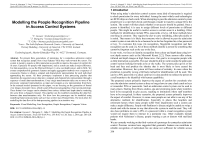Modelling the people recognition pipeline in access control systems
Автор: Gossen F., Margaria T., Gke T.
Журнал: Труды Института системного программирования РАН @trudy-isp-ran
Статья в выпуске: 2 т.28, 2016 года.
Бесплатный доступ
We present three generations of prototypes for a contactless admission control system that recognizes people from visual features while they walk towards the sensor. The system is meant to require as little interaction as possible to improve the aspect of comfort for its users. Especially for people with impairments, such a system can make a major difference. For data acquisition, we use the Microsoft Kinect 2, a low-cost depth sensor, and its SDK. We extract comprehensible geometric features and apply aggregation methods over a sequence of consecutive frames to obtain a compact and characteristic representation for each individual approaching the sensor. All three prototypes implement a data processing pipeline that transforms the acquired sensor data into a compact and characteristic representation through a sequence of small data transformations. Every single transformation takes one or more of the previously computed representations as input and computes a new representation from them. In the example models presented in this paper, we are focusing on the generation of frontal view images of peoples’ faces, which is part of the processing pipeline of our newest prototype. These frontal view images can be obtained from colour, infrared and depth data by rendering the scene from a changed viewport. This pipeline can be modelled considering the data flow between data transformations only. We show how the prototypes can be modelled using modelling frameworks and tools such as Cinco or the Cinco-Product Dime. The tools allow for modelling the data flow of the data processing pipeline in an intuitive way.
Visual modelling, face recognition, people recognition, computer vision
Короткий адрес: https://sciup.org/14916340
IDR: 14916340 | DOI: 10.15514/ISPRAS-2016-28(2)-14
Список литературы Modelling the people recognition pipeline in access control systems
- G. S. Gagandeep Kaur and V. Kumar, “A review on biometric recognition,” International Journal of Bio-Science and Bio-Technology, vol. 6, no. 4, pp. 69-76, 2014.
- Z. Zhang, “Microsoft kinect sensor and its effect,” IEEE MultiMedia, vol. 19, no. 2, pp. 4-10, 2012.
- F. Gossen, “Bayesian recognition of human identities from continuous visual features for safe and secure access in healthcare environments,” in Design Technology of Integrated Systems in Nanoscale Era (DTIS), 2015 10th International Conference on, 2015.
- I. Marqués and M. Graña, Computational Intelligence in Security for Information Systems 2010: Proceedings of the 3rd International Conference on Computational Intelligence in Security for Information Systems (CISIS’10), ch. Face Processing for Security: A Short Review, pp. 89-96. 2010.
- T. Cover and P. Hart, “Nearest neighbor pattern classification,” Information Theory, IEEE Transactions on, vol. 13, no. 1, pp. 21-27, 1967.
- “Rapid miner.” https://rapidminer.com/. Accessed: 2016-02-02.
- “Openni 2 sdk.” http://structure.io/openni. Accessed: 2016-04-01.
- S. Naujokat, L.-M. Traonouez, M. Isberner, B. Steffen, and A. Legay, Leveraging Applications of Formal Methods, Verification and Validation. Technologies for Mastering Change: 6th International Symposium, ISoLA 2014, Imperial, Corfu, Greece, October 8-11, 2014, Proceedings, Part I, ch. Domain-Specific Code Generator Modeling: A Case Study for Multi-faceted Concurrent Systems, pp. 481-498. Springer Berlin Heidelberg, 2014.
- S. Naujokat, M. Lybecait, B. Steffen, D. Kopetzki, and T. Margaria, “Full generation of domain-specific graphical modeling tools: a meta modeling approach.” under submission, 2015.
- “Cinco scce meta tooling framework.” http://cinco.scce.info/. Accessed: 2016-04-01.


